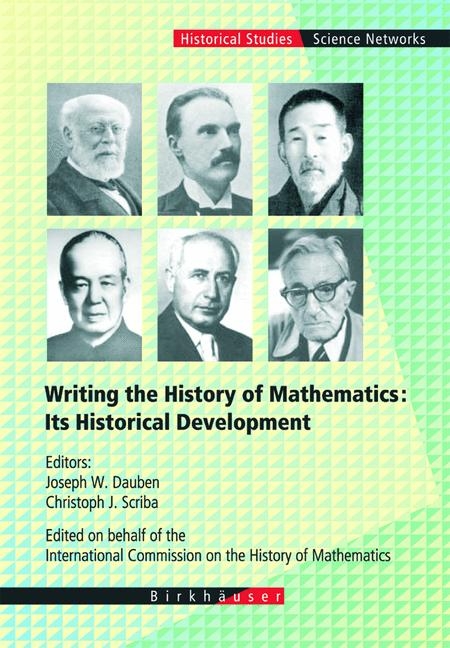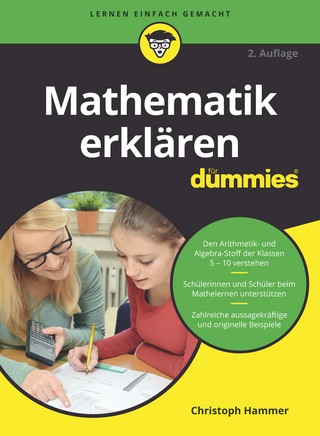
Writing the History of Mathematics: Its Historical Development
Springer Basel (Verlag)
978-3-7643-6166-2 (ISBN)
- Titel ist leider vergriffen;
keine Neuauflage - Artikel merken
I Countries.- 1 France.- 1.1 Introduction.- 1.2 Changing Appreciation of the Ancients, from the Renaissance to the Seventeenth Century.- 1.3 History of the Progress of the Human Mind (in the Enlightenment).- 1.3.1 Fontenelle, the Initiator of a Tradition.- 1.3.2 The Historical Dimension of the Encyclopedia Project.- 1.3.3 Montucla’s Monumental Work.- 1.4 Historiography in Revolutionary Times.- 1.5 The Reform of Society Through the Sciences: Positivism.- 1.6 Oriental Studies and the History of Mathematics in the Nineteenth Century.- 1.6.1 Collaboration Between Scientists and Orientalists.- 1.6.2 Academic Controversies on the History of Arabic Mathematics.- 1.6.3 François Woepcke’s Research.- 1.7 The History of Mathematics by Mathematicians: Chasles and his Successors.- 1.8 The Spread of Historical Work in Journals and the Broadening of the Subjects Treated.- 1.9 The History of Mathematics in Relation to the General History of Science: Paul Tannery.- 1.10 Nationalist Tendencies.- 1.11 Philosopher-Scientists of the Twentieth Century.- 1.12 The History of Mathematics and the Institutionalization of the History of Science Between the Two World Wars.- 1.13 The Historical Epistemology of Gaston Bachelard.- 1.14 Towards an Autonomous History of Mathematics After the Second World War.- 1.15 The Centre Alexandre Koyré and Research on the History of Mathematics.- 1.16 History According to Bourbaki.- 1.17 Further Developments.- 1.18 Conclusion.- 2 Benelux.- 2.1 Geographical and Political Considerations.- 2.2 Humanist-Inspired Return to the Sources.- 2.3 Catalogues of Mathematicians.- 2.4 The Eighteenth Century.- 2.5 Historiography of Mathematics in the Kingdom of the Netherlands 1815–1830.- 2.6 Historiography of Mathematics in Belgium after 1830.- 2.7 Historiography of Mathematics in the Netherlands after 1830.- 2.8 Amateurs and Professionals, Journals and Societies.- 2.9 Conclusion.- 3 Italy.- 3.1 Introduction.- 3.2 The Rediscovery of Classical Mathematics.- 3.3 Interlude: Contributions of the Jesuits.- 3.4 The History of Mathematics in the Enlightenment.- 3.5 History as a Research Topic for Mathematicians.- 3.5.1 Pietro Cossali.- 3.5.2 Gregorio Fontana.- 3.5.3 Giovanni B. Venturi and Pietro Franchini.- 3.5.4 The Influence of Lagrange.- 3.5.5 Guglielmo Libri.- 3.6 The Risorgimento and the Search for Italian Forerunners.- 3.7 Boncompagni’s “Bullettino” and Its Influence.- 3.8 The History of Mathematics in the Early Twentieth Century.- 3.8.1 The School of Peano in Turin.- 3.8.2 The School of Enriques in Bologna.- 3.9 Second Interlude: Galileo and Leonardo.- 3.10 The Emergence of Professional Historians.- 3.10.1 GinoLoria.- 3.10.2 Ettore Bortolotti.- 3.11 Enriques and the Institute for the History of Science in Rome.- 3.12 After World War II.- 3.13 Conclusion.- 4 Switzerland.- 4.1 Introduction.- 4.2 Humanism and Enlightenment.- 4.3 The Contribution of the “Naturforschende Gesellschaften”.- 4.4 The Major Editions.- 4.5 Further Developments.- 4.6 Conclusion.- 5 Germany.- 5.1 Introduction.- 5.2 The Beginnings.- 5.2.1 The First Glimmer: Regiomontanus and Some Successors.- 5.2.2 Two Extremes: Leibniz and Wolff.- 5.2.3 Three Additional Eighteenth-Century German Authors.- 5.2.4 Mathematician, Bibliographer and Epigrammatist: Kästner.- 5.3 First Half of the Nineteenth Century.- 5.3.1 Prom Watch-Maker to Professor of Technology: Poppe.- 5.3.2 Handbooks and History: Klügel and Mollweide.- 5.3.3 Opposite Twins? Nesselmann and Arneth.- 5.4 From 1850 up to World War I.- 5.4.1 The “Philologists”: Editions of Texts.- 5.4.2 Hermann Hankel and Moritz Cantor: First Comprehensive Studies.- 5.4.3 Günther and Braunmühl: On the Way to Professionalism.- 5.4.4 Felix Klein and His “Vorlesungen.” Editions of “Collected Works”.- 5.5 Between the Wars.- 5.5.1 More Studies on Arabic Mathematics.- 5.5.2 Toeplitz, Neugebauer, and Bessel-Hagen: The “Kiel-Göttingen-Bonn Group”.- 5.5.3 Wieleitner, Tropfke, and Their Successors Vogel and Hofmann.- 5.6 History of Mathematics Under the Third Reich.- 5.7 The German Democratic Republic.- 5.8 The Federal Republic of Germany.- 5.9 History of Mathematics in a Reunited Germany.- 5.10 Conclusion.- 6 Scandinavia.- 6.1 Introduction.- 6.2 Early Publications on the History of Mathematics.- 6.3 National Interests.- 6.4 Professional History of Mathematics.- 6.5 Eneström’s Scientific History of Mathematics.- 6.6 Zeuthen’s Historical Mathematics.- 6.7 Text Editions.- 6.8 After Eneström and Zeuthen.- 6.9 Conclusion.- 7 The British Isles.- 7.1 Introduction.- 7.2 Prior to the Early Twentieth Century.- 7.3 Studies of Special Topics.- 7.4 Largely Historians of Newton.- 7.5 Some Cambridge Historians.- 7.6 The Royal Society Catalogue of Scientific Papers.- 7.7 Historians of Greek Mathematics.- 7.8 General Writing to the First World War.- 7.9 Pearson and the History of Statistics.- 7.10 Between the Wars.- 7.11 After the Second World War.- 7.12 Conclusion.- 8 Russia and the U.S.S.R..- 8.1 Introduction.- 8.2 History of Mathematics Before 1917 179 The First Post-Revolutionary Years: Formation of the Soviet School.- 8.3 Research Schools After World War II.- 8.4 Dominant Postwar Research Themes and Publication Formats.- 8.5 Social Dimensions of the History of Mathematics After World War II.- 8.6 Conclusion.- 9 Poland.- 9.1 Early Developments.- 9.2 Twentieth-Century Contributions.- 9.3 Conclusion.- 10 Bohemian Countries.- 10.1 Introduction.- 10.2 Beginnings.- 10.3 History of Mathematics 1750–1850.- 10.4 The Mid-19th Through the Mid-20th Century.- 10.5 History of Mathematics in Czechoslovakia Since 1945.- 10.6 Conclusion.- 11 Austria.- 11.1 Introduction.- 11.2 Regiomontanus and Tannstetter.- 11.3 Decline and Revival.- 11.4 The “Encyklopädie”.- 11.5 Recent Developments.- 11.6 Conclusion.- 12 Greece.- 12.1 The Classical and Hellenistic Periods.- 12.2 The Byzantine Period.- 12.3 Voulgaris and the Athonian Academy.- 12.4 The Ionian Academy.- 12.5 The Greek National State (1822 to the Present).- 12.6 Conclusion.- 13 Spain.- 13.1 Introduction.- 13.2 Polemics With Respect to Sixteenth-Century Spanish Mathematicians.- 13.3 Mathematics in the Liberal State.- 13.4 Conclusion.- 14 Portugal.- 14.1 Introduction.- 14.2 The Beginnings: Garção Stockier.- 14.3 The Second Half of the Nineteenth Century: Francisco de Castro Freire.- 14.4 The Golden Age of Portuguese Historiography of Mathematics: 1900–1940.- 14.5 The Modern Period: 1940–1970.- 14.6 Conclusion.- 15 The Americas.- 15.1 Introduction.- 15.2 South America.- 15.2.1 Historiographical Remarks.- 15.2.2 Conquest and Early Colonial Times.- 15.2.3 The Established Colonies.- 15.2.4 Independent Countries.- 15.2.5 The Twentieth Century.- 15.2.6 Current Developments.- 15.2.7 Conclusion.- 15.3 Mexico.- 15.3.1 The Creation and Development of the Royal University.- 15.3.2 After Independence.- 15.3.3 The Emergence of Modern Mathematics in Mexico in the Twentieth Century: The Autonomous National University.- 15.3.4 The Faculty of Sciences.- 15.3.5 The Nightmare: The 1968 Student Movement.- 15.3.6 Conclusion.- 15.4 United States of America.- 15.4.1 Introduction.- 15.4.2 History of Mathematics in the United States: Early Efforts Through World War I.- 15.4.3 Increasing Professionalization: History of Mathematics and History of Science.- 15.4.4 Recent History of Mathematics in the United States.- 15.4.5 Conclusion.- 15.5 Canada.- 15.5.1 Before 1966.- 15.5.2 Kenneth O. May.- 15.5.3 The Situation Today.- 16 Japan.- 16.1 The Prewar Period, 1868-1945: The Flowering of the Study of the History of Japanese Mathematics.- 16.1.1 End? Toshisada and His Successor Mikami Yoshio.- 16.1.2 The T?hoku School.- 16.2 The Postwar Period, 1945–1986: Beginnings of the Serious Study of the History of Western Mathematics.- 16.3 Conclusion.- 17 China.- 17.1 The Decline of Traditional Chinese Mathematics.- 17.2 Early Authors.- 17.3 The “Qian-Jia School” and Its Successors.- 17.4 The Modern Scholars.- 17.5 Conclusion.- 18 India.- 18.1 Introduction.- 18.2 Beginnings of Indigenous Historiography.- 18.3 Modern Historical Studies and Historiography of Indian Mathematical Sciences.- 18.4 Indian Historians.- 18.5 The Twentieth Century.- 18.6 Conclusion.- 19 Arab Countries, Turkey, and Iran.- 19.1 Introduction.- 19.2 Exchanges with Western Europe.- 19.3 A New Start for Historiography of Science and Mathematics.- 19.4 Diverse Attitudes towards History of Science and Mathematics.- 19.5 Trends in History of Mathematics in Iran and Turkey.- 19.6 The New Institutions.- 19.7 Conclusion.- 20 Postscriptum.- 20.1. The Character of Historiography.- 20.2 George Sarton’s Views.- 20.3 Interrelations.- 20.4 On the History of Historiography.- 20.5 Functions of Historiography.- 20.6 Institutional Factors.- 20.7 History of Mathematics and Mathematics Education.- 20.8 History of Mathematics: Recent Trends.- 20.9 Electronic Resources.- 20.10 The Humanism of Mathematics.- II Portraits and Biographies.- Portraits.- Biographies.- III Abbreviations, Bibliography, and Inde.- Abbreviations.
| Reihe/Serie | Science Networks. Historical Studies |
|---|---|
| Zusatzinfo | XIX, 689 p. 13 illus. |
| Verlagsort | Basel |
| Sprache | englisch |
| Maße | 178 x 254 mm |
| Gewicht | 1430 g |
| Themenwelt | Mathematik / Informatik ► Mathematik ► Allgemeines / Lexika |
| Schlagworte | Geschichte der Mathematikgeschichtsschreibung • Hardcover, Softcover / Mathematik/Allgemeines, Lexika • HC/Mathematik/Allgemeines, Lexika |
| ISBN-10 | 3-7643-6166-2 / 3764361662 |
| ISBN-13 | 978-3-7643-6166-2 / 9783764361662 |
| Zustand | Neuware |
| Haben Sie eine Frage zum Produkt? |
aus dem Bereich


